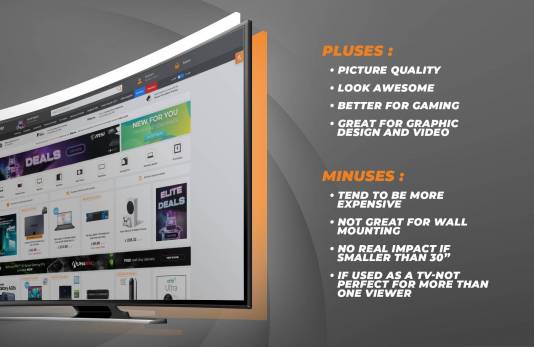This blog was updated in May 2022.
You may remember back when curved monitors first debuted on the consumer market in 2014. Many thought they’d be a passing fad, akin to the short-lived 3-D TV craze, but curved monitors have stuck around and are more popular than ever. But are curved monitors actually worth it? That’s the big question. Let’s look at the advantages curve monitors bring to the table, and whether they justify their price tag.
What are Curved Monitors?
It may be stating the obvious, and you could probably guess, that curved monitors feature a slight curvature. Whether for work or play, this curvature can help a curve monitor align with your field of view, making for a more comfortable and immersive viewing experience.
How strongly it curves is measured by its radius (or ‘R’) in millimetres. When browsing Ebuyer’s range of curved monitors, you’ll find most models have one of three common ‘R’ sizes: 1000R, 1500R, and 1800R. The smaller the number, the bigger the curve. This isn’t every measurement a curved monitor comes in, as you’ll find radiuses up to 3000R or even 4000R for a gradual, subtle curve.
Curved monitors come in sizes as small as 24-inches, but if you’ve got the room for it, it’s better to get a curved monitor that’s on the large size. To fully get the intended effect of a curved monitor, you’ll need one that’s at least 30-inches or more. As the smaller you go, the more the effect diminishes.
The general rule is that the best curved monitors are the largest, widest ones, or ‘ultrawide curved monitors.’ These give you ample room to comfortably arrange several windows and applications at once.
When curved monitors debuted, there was quite a bit of confusion as to which one was the best – curved monitors or flat displays. While curved monitors are easier on the eyes and can help reduce eye strain over marathon gaming and moving-watching sessions, there are lots of things to consider when choosing a curved monitor. So, let’s do a comparison.
Curved Monitor vs Flat – Which Should You Buy?

There’s a measurable difference when looking at a curved monitor vs flat. But are curved monitors better? For content creation, movies, and gaming, a curved monitor gets you a wider field of view for more immersive experiences.
The main drawback of a curved monitor used to be its price. People had become accustomed to a flat display and felt this new, expensive technology wasn’t worth the upgrade. Nowadays, curved monitors are considerably cheaper. They’ve gotten so cheap in fact, that a curved monitor may be less expensive than its flat counterpart.
So, you don’t need to factor price into the equation when choosing between a flat and a curved monitor. Rather, you should consider the image quality and the level of immersion you’ll get.
Most curved monitors are also ultrawide monitors, which at minimum come in a 21:9 aspect ratio. That’s 33% more compared to a standard 16:9 aspect ratio. A wider aspect ratio further expands the field of view, making it even more engaging. And 21:9 is only the beginning, there are also ‘super-ultrawide’ curved monitors in a 32:9 aspect ratio for IMAX-style viewing.
Pros of Curved Monitors

• A curved monitor mimics your eyes’ curvature for a more comfortable viewing experience, less eye strain.
• More in your periphery, don’t have to twist neck as much and more immersive gaming.
• Better viewing angles.
• Compared to a multi-monitor set-up, one larger curved monitor saves on desk space.
• There’s a wider selection of ultrawide curved monitors than there is ultrawide flat display.
• The cost of a curved monitor isn’t more than a flat display, it’s sometimes cheaper.
Less Movement
A curved monitor can help reduce eye strain and minimise neck movement whilst working and gaming. As you’re always roughly the same distance from every part of a curved monitor, you don’t need to move as much to glance from one edge to another. Having more monitor in your periphery may be advantageous for gamers, since they’ll be able to notice opponents crawling into view easier.
In addition, a curved monitor’s ‘surround’ effect cancels any distortion that you’d get on a flat display. On a flat display, the edges are further away from the centre of your vision, so your eyes have to work harder to view the image at unequal distances.
Multi-Monitor Set-Up

This is one of the main advantages of a curved monitor. If you’re wanting a multi-monitor set-up, curved monitors enable a much smoother and natural transition from one to another. Alternatively, you could ditch a multi-monitor set-up entirely and go with one ultrawide curved monitor instead. This not only gets rid of bezels in-between the monitors, but it also saves on desk space as you’ll only need a single monitor stand or mount.
Better Viewing Angles

A bigger curve provides a wider viewing angle. When viewing a flat, non-IPS display from anything other than head-on, the viewer often loses out on contrast and saturation. It becomes ‘washed out’ due to the way in which light is projected from the display.
As every part of a curved monitor is angled more towards the viewer, this effect is minimised. The bend compensates for it, giving you a wider viewing angle than an ordinary flat display.
Cons of Curved Monitors
Although a curved monitor has a leg up over a flat display in many ways, there are some slight downsides to consider.
• For the best viewing experience, a curved monitor must be viewed head-on.
• Prone to glare.
• Wall or arm-mounting a curved gaming monitor may be tricky.
• For the greatest impact, a curve monitor must be quite large.
Is Distortion an Issue?

A curved monitor works best when you’re directly centred with it. If you sit off-centre, however, you may notice colour distortion. Some people also notice slight geometric distortion on a curved monitor. Most notably, there can be a ‘bow tie’ effect, in which the edges appear stretched compared to the centre. This one’s a bit contentious as many people simply don’t pick up on any distortion from a standard viewing angle.
For the most part, it’s only when you go unrealistically off-centre that these issues come into play. It may be a bigger deal when several people are gathered round a curved TV at various angles, but a curved monitor is designed for a sole user.
Can Curved Monitor be wall mounted?
As you can imagine, wall-mounting a curved monitor won’t look as good as a flat display, as the monitor isn’t flush against the wall. Regardless, some people do wall-mount a curved monitor, and there are mounts that account for the curvature. For some, a curved monitor may look out of place hanging from a wall or arm-mount, but it’s a personal choice.
Are curved monitors better than flat?

Curved monitors are a fantastic choice if you’re looking for comfortable working and immersive gaming. Most people don’t appreciably notice a curved monitor, but for gaming and content creation, they’re a favourite for many.
Looking back at our list of downsides to buying a curved monitor, glare is the biggest question mark. It’s not like a flat display is impervious to glare either, but it’s easier to adjust and cancel-out the glare to make your eyes more comfortable.
You’ll want to consider if the amount of time you use your computer for justifies a curved monitor. Serious gamers and those who spend hours in front of their display, such as designers, editors, and content creators, would benefit the most from a curved monitor. Since these displays tend to come in ultrawide models, they’re also a great fit for heavy multitaskers.
After weighing up the pros and cons of a curved monitor, you can deliberate which model to buy. It’s largely your budget which dictates the curved monitor you’ll be able to get. If you have a decent budget and you’ve got the room to support it, our recommendation is to ‘go big’. You can get a surprisingly cheap ultrawide curved monitor, if you aren’t too concerned with high refresh rates and other gaming credentials.
A larger display at a tighter curvature results in a more natural experience. Though, not all curved monitors are created equal. For instance, curved monitors made for gaming tend to exhibit the tightest radiuses for the best immersion.
Curved Monitors FAQ
Here’s a quick round-up of all the key points we covered above.
What’s the main advantage of a curved monitor vs flat?
As a curved monitor matches the curvature of a human eye more closely, your eyes feel more relieved when viewing a curved monitor from a close distance. Due to the curvature, your eyes are equidistant to a curved monitor at any angle. In contrast, a flat display projects its image in a straight line, both at and past the viewer’s side. A curved monitor, on the other hand, uses its shape to direct everything at the viewer, thereby minimising distortion.
Can multiple people view a curved monitor?
No, not really. The viewer who sits right in front of a curved monitor or slightly off-centre enjoys the best viewing experience. The farther away from the centre a view is, however, the more the image becomes less viewable. Also, you must bear in mind watching a curved monitor at an uncomfortable angle for an extended period of time may result in eye strain.
What sized curved monitor should I get?
To get your money’s worth out of a curved monitor, you’ll want to go as large as possible, since the curve’s effect is diminished at smaller sizes. This includes 30″ to 32″ monitors, all the way up to 34″ + monitors. The extra depth of a curved monitor may take up more desk space than a flat display that’s mounted flush against a wall. However, if you have one ultrawide curved monitor as opposed to a multi-monitor set-up, you won’t need as many stands and mounts. And one large curved monitor is easier to work on then two flat screen monitors. So, a curved monitor trades blows with a flat display in regard to space.
Do I need a curved monitor that’s also ‘ultrawide’?
No, but the wider a curved monitor, the better, as its delivers extra depth, detail, and immersion. A monitor with a smaller aspect ratio can’t compete in this regard. Remember, a curved monitor already gets you a more immersive experience than your average flat display, but an ultrawide curved monitor takes it to the next level.
Is a flat screen display cheaper than a curved monitor?
Nowadays, the answer is no, not always. When curved monitors first debuted, they might’ve cost more than a flat display, as is always the case with new technology. Over time, however, the cost of a curved monitor has plummeted, to the point where it may now be less expensive than its flat counterpart. As with all monitors, the price mainly varies depending on resolution, refresh rate, size, features, and I/O.
Curved or flat monitor for gaming?
Whether to use a curved or flat monitor for gaming is up for debate, and it largely boils down to personal preference. Through years of gaming, many have become accustomed to a flat display. Changing to a curved monitor from a flat one may feel disorienting and mess up your muscle memory at first.
But give a curved monitor some time, and its advantages become apparent. It’s due to that word – immersion. A curved monitor wraps around your periphery and is easier on the eyes, making it ideal for more simulation-focused games and marathon sessions. For a gaming monitor, however, you should focus on a monitor’s tech-specs, such as refresh rate and response time.
Curved Monitors at Ebuyer
We hope you’ve had some food for thought and you’re now more aware of what a curved monitor provides. Check out Ebuyer’s range of monitors, here…



